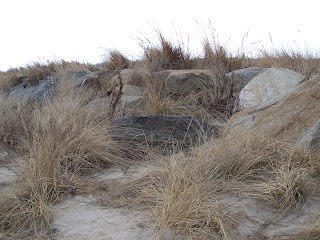 |
Fire and Amulet by Helen Henderson Click the cover for purchase information |
The dog days of summer arrived before the solstice, which is considered by many as the official start of summer. Every weather report comes with the warning not to leave children or pets in a car. Some stores have even placed signs at their entrances asking ,"Did you check your back seat?" Temperatures kissing 100 degrees Fahrenheit are bad enough. However, high humidity coming up from the Gulf of Mexico makes for a feel-like temperature of 125 degrees.
Some people may love lying on a beach in this weather and the heat and humidity doesn't bother them. I admit at this stage of my life, I prefer other activities. Since sitting beneath a tree watching boats go up and down the river is no longer feasible, you can find me hiding behind the insulated, thermal windows of my air-conditioned room and watching the cardinals fly from tree to tree.
 | |
| Monmouth County NJ Sand Dunes |
Conditions outside can translate into an author's work. My childhood on a farm provided many opportunities to work in the sun in the fields, but also to lie in the shade beneath an ancient willow tree. My experiences with the southwestern desert have been minimal, but I did technically visit a desert -- the Desert of Maine. And the miles of the Jersey Shore can present their own impediment to walking as you slog through the steep sand dunes.
Since I will not give my characters the luxury of air-conditioning, they have to find other means of escaping the torrid temperatures. If I am feeling charitable, I might allow the characters to escape the heat in a cave. Here is one occurrence of how the weather outside translated to the world of Fire and Amulet that Deneas experienced.
Nighttime breezes accentuated the crisper air of harvest season that had accompanied the last few days of her travel. The cooler temperatures came with daytime storms that kept her huddled beneath her cloak for what little shelter it provided. Although the rain and lightning restricted her movement, it did little to stop her mind from roaming down untenable paths.The last part of the excerpt came from the tending of the tomato, cucumber, and pepper plants outside my back door.Worries about her future, whether Geren and his new bride were happy in Nawddmir, and if Drakus, Hiryur, and their herd had found safe pasture, mingled with memories.
The cool air recalled all the times she hid in Trelleir’s cave to escape the desert heat that scorched Darceth in the summer months. Not even the dark hours provided respite from the heat that burned your lungs and stole what little energy one could summon. In the few steps from the communal well to the garden, even without a single splash or spill, the full bucket emptied by half.
Oh, as to why "dog days?" According to National Geographic, the Greeks and Romans named them for the period of time each summer when the dog star, Sirius appears to rise alongside the sun. "They believed the heat from the two stars combined is what made these days the hottest of the year, a period that could bring fever or even catastrophe."
To purchase Fire and Amulet: BWL
~ Until next month, stay safe and read.
Find out more about me and my novels at Journey to Worlds of Imagination.
Follow me online at Facebook, Goodreads or Twitter.
Helen Henderson lives in western Tennessee with her husband. While she doesn’t have any pets in residence at the moment, she often visits a husky who has adopted her as one the pack.


.jpg)

























